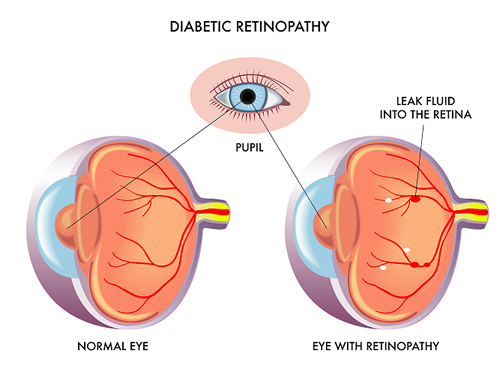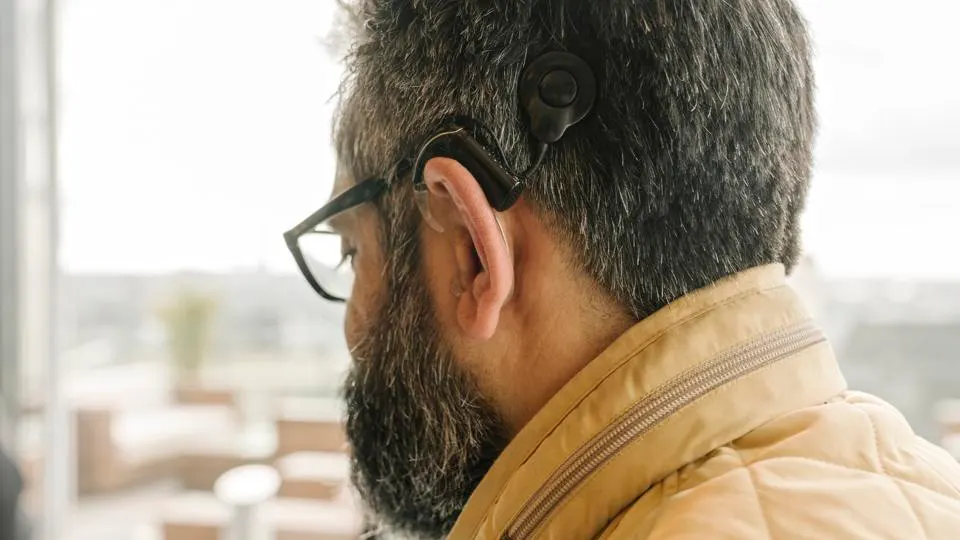What is Diabetic Retinopathy?
Diabetic retinopathy is a complication of diabetes that occurs from damage to the tiny blood vessels inside the retina. These weak vessels are prone to hemorrhaging. Leaking vessels can cause fluid to accumulate at the center of the retina causes your vision to blur. The leaking vessels also lead to the formation of scar tissue and too much scar tissue can result in retinal detachment which can lead to visual impairment and blindness.
Your risk of developing diabetic retinopathy increases the longer you have diabetes. This disease affects approximately 40-45% of Americans who have diabetes.
When Should I see a Doctor for Diabetic Retinopathy?
Often, the condition will not cause any noticeable symptoms, even after the retina has sustained damage. While routine eye examinations are important for everyone, comprehensive dilated eye examinations are particularly crucial for diabetics. Many people wait to visit our eye doctors until they experience blurry vision or vision loss yet, you can have diabetic retinopathy without experiencing any symptoms. Early detection through an eye examination can help prevent serious visual complications.
Symptoms of diabetic retinopathy include usually affecting both eyes:
- Blurred vision
- Spots or floaters in your vision
- Difficulty seeing at night
- Dark or empty spots in your vision
- Vision loss
Doctors consider this condition a serious medical emergency and you should seek treatment right away to help you to guard against permanent and irreversible vision loss.
Diabetic Patients
If you have been previously diagnosed with diabetes you are at an increased risk for developing glaucoma & cataracts. It is especially important for you to keep up with yearly eye exams and discuss any vision concerns with your doctor.
Contact Our Team to Schedule an AppointmentWhat are the Different Stages of Diabetic Retinopathy?
Diabetic retinopathy has four stages, each one increasingly serious:
- Mild nonproliferative retinopathy
- Moderate nonproliferative retinopathy
- Severe nonproliferative retinopathy
- Proliferative retinopathy
As the disorder worsens, more and more blood vessels are affected. By the time a patient has proliferative retinopathy, the body is creating new blood vessels to replace the ones that are blocked. The problem is that the new blood vessels have very thin walls. If they leak blood, severe vision loss or blindness can result.

How is Diabetic Retinopathy Diagnosed?
Diagnosis of diabetic retinopathy requires a thorough eye examination that includes the following:
- Visual-acuity test
- Dilated-eye examination
- Tonometry test
- Retinal exam
- Fluorescein angiogram
Prior to some of these tests, eye drops containing a stain are administered so that the doctor can see the blood vessels more clearly.
What are the Treatments for Diabetic Retinopathy?
Other than controlling blood pressure, blood cholesterol and blood sugar, treatment is not needed during the first three stages of diabetic retinopathy. The fourth stage, proliferative retinopathy, is treated with a laser surgery known as scatter laser treatment. During the procedure, the abnormal blood vessels are ablated, causing them to shrink. This procedure works best once the blood vessels begin to bleed. Severe blood-vessel bleeding may need to be surgically corrected with a vitrectomy, during which blood is removed from the eye.
Treatment for macular edema usually includes a laser procedure called focal laser treatment. During this procedure, several hundred small laser burns are made in the areas of retinal leakage to reduce the amount of fluid in the retina. This helps reduce the risk of vision loss, and may improve lost vision in a small number of cases. Focal laser treatment is performed in a doctor’s office, and can usually be completed in just one session.
What Should I Expect with Recovery for Diabetic Retinopathy?
Depending on the severity of your condition, particularly if macular edema is present, you may need extra treatment sessions. Some patients suffering from advanced PDR may need up to three or four laser treatment sessions.
Reducing the Risk of Diabetic Retinopathy
A patient with diabetes should have an annual comprehensive dilated-eye exam. In the United States, more than 40 percent of diabetics have some form of diabetic retinopathy.
The risks of developing diabetic retinopathy can be minimized by doing the following:
- Monitoring changes in vision
- Keeping blood-glucose levels low
- Monitoring and managing blood pressure
- Eating a healthy diet
- Participating in a regular exercise routine
- Monitoring and managing cholesterol levels
Patients with proliferative retinopathy can reduce their risk of blindness by 95 percent by keeping up with medical examinations, and promptly getting necessary treatment.
Contact SightMD today to schedule an appointment with one of our doctors to discuss your vision health at one of our convenient locations!

Healthy Diet and Cataracts
The Role of a Healthy Diet in Preventing Cataracts As we age, various eye conditions can develop that impact…

Benefits of Cochlear Implants
Understanding the Benefits of Cochlear Implants Hearing loss can significantly impact one’s quality of life, making communication and connection…

Long-Term Considerations for Individuals with Cataracts
What to consider Long-Term for Individuals with Cataracts As we age, our eyes undergo various changes, and one common…